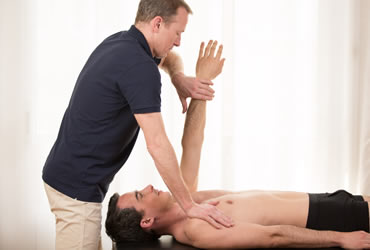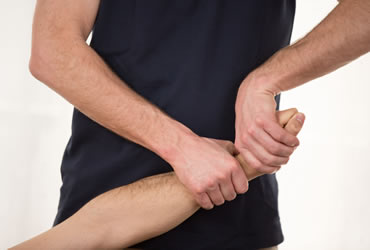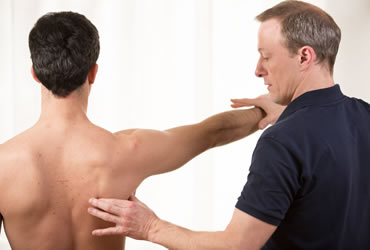Applied kinesiology is a functional neurological diagnosis through the muscular testing. With the results of the testing and through the application of various specific external stimuli, the therapist can classify the cause of muscle dysfunction.
By applying various specific external stimuli (manual arrangement, lymphatic drainage, application of vitamins, massage, etc ...) the therapist can diagnose the cause of the dysfunction and treat it with different physiotherapeutic, osteopathic and complementary medical techniques. An inhibited muscle will immediately change its state when the therapist applies the appropriate stimulus. Likewise, the effect of the treatment and the prognosis can be assessed.
With the results of the applied kinesiology tests, an individual treatment plan is developed using the following methods:
- chiropractic
- osteopathy
- BMS (biomechanical stimulation)
- FDM (fascial distortion model) according to Dr Stephen Typaldos
- neural therapy
- acupuncture
- orthomolecular medicine
- electromagnetic fields
- dental focus healing, in cooperation with dentists
- nutritional medicine
- homeopathy
- Bach flowers
- and more…
We are looking for the causes of the problem and we intend to capture it in its complexity and fix it permanently, and not only manage the symptom permanently.



What ailments and diseases can be treated using applied kinesiology?
At the muscular level (muscle - skeletal) ...
- Dysfunctions - muscle and joint pain (with or without existing pathology)
- Lower back pain
- Back pain
- Tendinitis
- Cervical pain
- Protrusions and herniated discs
- Sports injuries acute / cronic and/or recurrences
- etc.
At the visceral level ...
- Digestive system
- Food intolerances
- Candidiasis (fungal infection)
- Hiatus hernia
- Irritable bowel syndrome
- Premenstrual syndrome
- Constipation
- etc.
At the cranial level ...
- Temporomandibular joint dysfunction
- Bruxisms
- Sinusitis
- Headache
- Migraines
- Vertigo
- Dizziness
- Nausea
- etc.
At a preventive level ...
- Recognize / identify the regulatory state of the body and prevent possible alterations of the nervous, organic or metabolic systems (for example: food intolerances).
...more…
- Chronic pain or tiredness
- hormonal and / or immunological dysfunctions
- PTSD
- Fatigue syndrom
- Fibromyalgia
...further...
Dental and orthodontic problems:
- dental splint test, to alleviate pain caused by a bad bite (headache, spine and limb pain)
- Stove infection
- interference fields
- TMJ disorders (Temporomandibular joint)
- heavy metal pollution.
In principle, applied kinesiology can be used for all diseases and complaints.
Examples:
First example:
Both , the colon (large intestine) and the muscles that mechanically secure the inner part of the knee (m. gracilis m sartorius), are innervated by the L2 segment (located in the lower back). A food allergy that produces an immune reaction in the intestinal mucosa, can cause afferent and recurrent vertebral block in the mentioned segment. As a consequence, there can be an inhibition of the medial musculature of the knee, where the patient suffers pain, which increases the possibility of traumatic injuries. Through oral administration of lactobacilli, the associated muscles recover their function and strength instantaneously, allowing the therapist to obtain the necessary information to carry out the causal treatment guidelines for knee pain.
Second example:
Patients with poor mandibular occlusion usually have short or long-term problems in TMJ (temporomandibular joint), which can cause cervical, headaches, dizziness, tinnitus. The therapist asks the patient to clench their teeth tightly while simultaneously exploring the inhibited musculature in the cervical area and shoulder girdle. The therapist introduces into the interocclusal space a lingual depressant that slightly releases the bad occlusion by balancing it, just as the muscle involved instantly recovers strength. After diagnosis, a dental treatment will be recommended to the patient.

